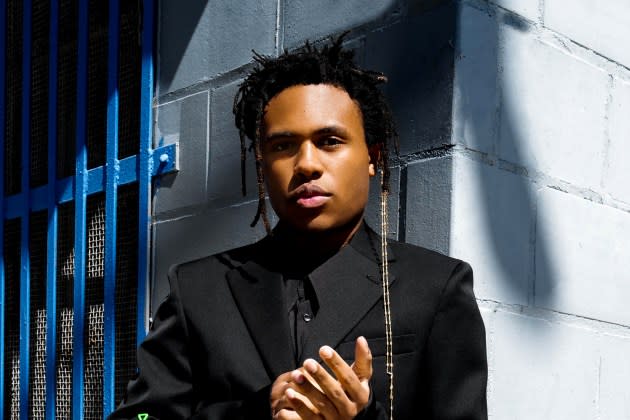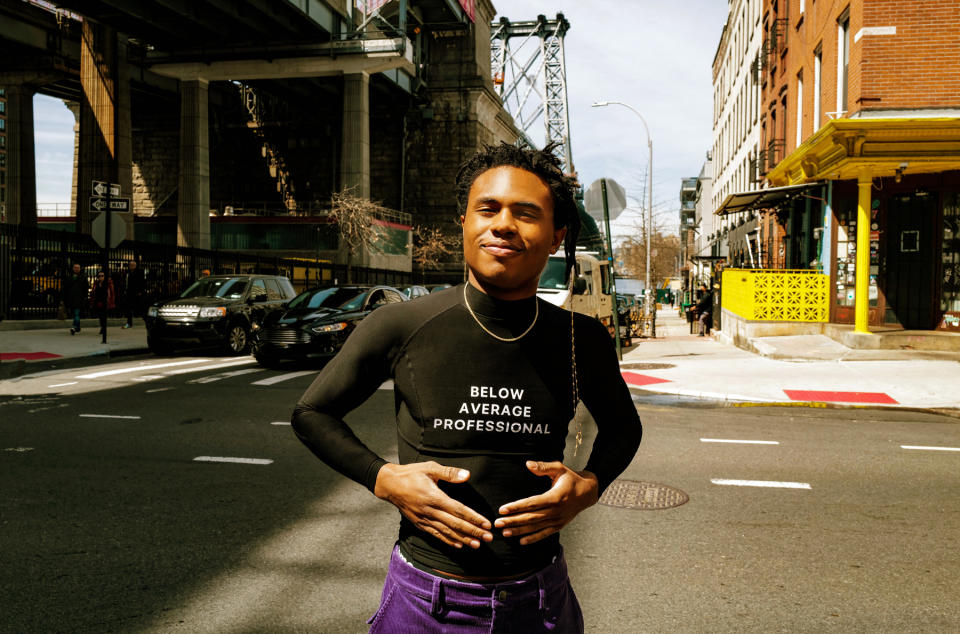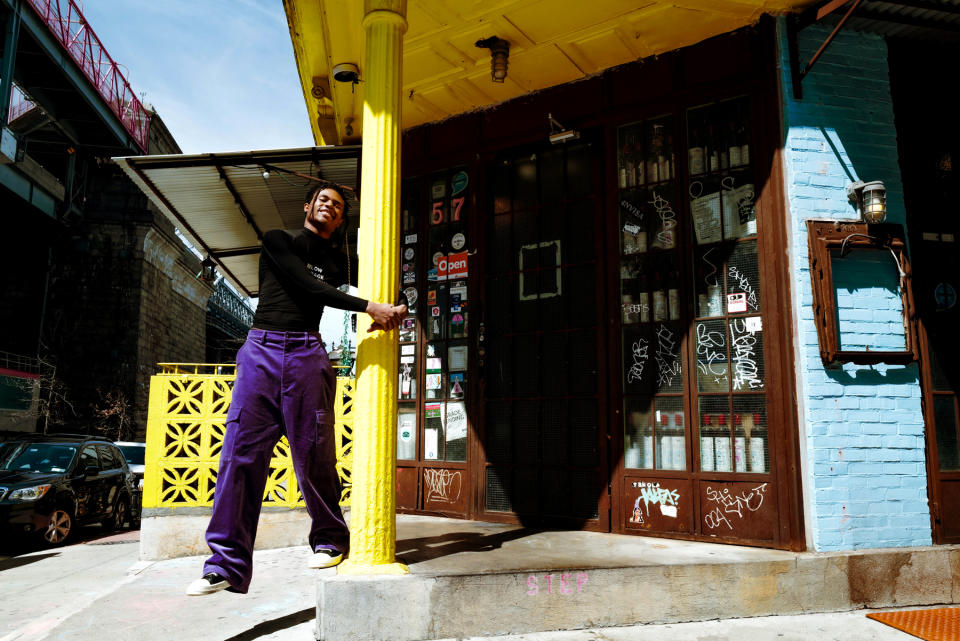Kailand Morris Is Building an Empire With Nothing To Prove and Everything To Gain
- Oops!Something went wrong.Please try again later.

Kailand Morris doesn’t look like the stereotype of someone who’s touched every facet of the fashion industry. When we meet at Le Crocodile, a brasserie in Williamsburg, Brooklyn, the 21-year-old designer is just in from Paris Fashion Week; dressed in a brandless white button-up, pressed grey AMI slacks, and “beat-up” Dior Jordans, he presents quite plainly but tidy. There are no flamboyant displays of colors or patterns, no logos emblazoned on the fabric, or excessive layering of any kind. His color palette is neutral, and accessories are kept quite minimal. However, there is thoughtfulness in what he’s decided to wear: He notes a broken necklace that holds sentimental value locked in his hair, and name-drops Alexandre Mattiussi, the designer of his slacks. “With everything I do, there’s always a story that’s being told behind it,” he remarks.
As we dissect his own work under the brand Iceberg and his experience working closely with Ye (a.k.a. Kanye West) at YEEZY, he speaks with the wide-eyed hunger of someone with an insatiable appetite for more. “I want people to see anything is fucking possible,” he says. And with Morris — the son of Stevie Wonder and a young creative who orbits the worlds of fashion, music, and fine art — it’s clear that these moments are only the beginning, his sights set even higher with his new label, House of K.O.M.
More from Rolling Stone
Related Stories
The Red Hot Chili Peppers x Noah Re-Visits the Band's Iconic Eighties Style

Watch Cher Walk the Runway at Balmain Fashion Week Show
The Best Sweatshirts You'll Want to Wear All Day
STEVIE WONDER’S KIDS have generally kept a low profile, with the possible exception of his daughter Aisha Morris, famed as the subject of his classic hit “Isn’t She Lovely.” But despite the lack of media frenzy typical to a family of this stature, Kailand Morris is no stranger to the public eye. He has walked more red carpets than one could ever remember, and has been front row at fashion events since he was four.
His mother, Kai Millard — the “OG inspo,” as Morris calls her — is a designer in her own right and part of the reason Morris felt drawn to the fashion industry. Over the decades, she has steadily built her career designing for the White House and the elites of Hollywood, exposing Morris to a world that would later become his own. “From what I remember, just me being young at these shows, I was always [thinking] this is really, really cool,” Morris says, although he adds that he never wanted to follow directly in her footsteps: “I just want to do my own thing.”

Morris sought independence, finding it first through the runway at the age of 16. Staged at the Metropol theater in the heart of Milan, studded with Italian stars like Isabella Rossellini and Monica Bellucci, Domenico Dolce and Stefano Gabbana’s SS19 show was the perfect platform for Morris to bustle into the mix.
But Morris was “never going to stop at walking fashion shows.” That was not the brand he had envisioned for himself. Instead of casual conversations with models behind the curtain, he wanted to understand and conquer it all. “I guess I was gaining a more personal one-on-one experience with the designers,” he says now. “Seeing how they operate.”
WHEN THE SUBJECT of his work with Ye comes up — a fact that hasn’t been widely reported outside the fashion industry — he lights up, eager for discussion. “It was terrible!” he jokes of his time with one of the most polarizing figures in modern culture. “No, man. I look at him like big bro.”
When the two met, they weren’t part of each other’s circles. In fact, Morris says Ye didn’t know who he was “until I told him” — a reasonable statement, given Morris’ minimal social presence. “I told him way after he looked at my portfolio, looked at my garments, and was interested in my clothes,” he adds.
Their first connection came through a stroke of fate. Morris recounts laying on his couch in his Calabasas home when his friend burst through the front door. “Yo, you won’t believe what just happened,” the friend shouted. “I met Ye! He wants to come buy your shirt right now.” The shirt in question, a sample collaboration between Morris and Sean Koons, son of famed artist Jeff Koons, had been loaned to his friend that afternoon for a quick trip to the market for a toothbrush.
“What do you mean buy?” Morris asked. “He really likes the shirt?” It was true — one of the most influential and controversial artists on the planet had been there at the store, not only intrigued by the design Morris had produced, but ready to buy it for himself.
“It’s such a funny story,” Morris says. “I truly believe everything happens for a reason. And it’s the timing, sequence of events…it could not have happened for me. Cause my friend could have gone to the store five minutes later.”
A member of Ye’s security team came to buy the shirt, followed by radio silence. Morris waited. Did this really just happen?
A few days later, Morris received a call from Ye’s team looking for additional designs and samples to produce under his label, YEEZY. Morris found himself on a plane to Atlanta, an opportunity he could not refuse, sketches in hand and unknowing of what was to come. “That’s how that working relationship started,” he says. “For a good while, I was with them in Atlanta. Working in the studio with his team. I was doing architecture design, just coming up with concepts. I was doing designs for a lot of the clothing and the Yeezy Gap stuff. I’d also be in there mixing dip dyes and playing with different colors and whatnot. It was really just however you can implement yourself in getting it done, let’s do it.”
Talking with Morris, it becomes clear that the brand functions the way you would imagine any brand to function under Ye — a bit mad-scientist. “They didn’t really have many labels at that time, like, ‘This is a creative director of this,'” Morris says. “You just have a bunch of creatives that are really good at specific things that are all working together.”
WE SHIFT TO discuss his collaborations with Iceberg, a label known most for its lux athleisure, and the relationship he built with the brand. After learning under the YEEZY empire, it was time to put his knowledge to the test.
Prior to working with the Italian house directly, Morris modeled in a few campaigns before striking up a conversation with creative director James Long. Long, whose innovative approach to sportswear has earned him accolades from glossy mags like Another Man and GQ, seemed quite fond of Morris from the start. “Collaborating with Kailand was so natural,” Long recalled in an interview with AsIf magazine. “He was very interested in the process of design. He loved coming to the studio and seeing how the clothes happen.”

The first capsule directed in collab with Morris’ label was launched in the fall of 2021 and featured the artwork of Vameee, an illustrator who intermixes nostalgic Nineties references with the style of Basquiat. For Morris, art and fashion are not mutually exclusive. Much like Kim Jones’ work at Dior, which he’s quite fond of, Morris blends the two worlds out of necessity. “I feel unjust if I don’t do work with artists, whether it’s through color Pantones, or artwork they do for the clothes,” he says.
Apart from the general athleisure nature of the collection — hoodies, sweats, and jumpers, all of which are staples to the Iceberg brand — there is a real insider quality to it. Embroidered flowers that look unraveled and pulled from the seams crudely emulate Takashi Murakami, the Japanese artist whose most famous works interlace his brief run at Louis Vuitton. Murakami developed a series of pop-art patterns with Marc Jacobs, helping turn Louis Vuitton into a modern and coveted status symbol. In a delicate and thoughtful manner, Morris was reinterpreting that legacy through his creative direction at Iceberg.
His satisfaction with the launch of the first collection was quickly overshadowed as he reflected and pushed on. “Every project I do, because I’m so self-critical, I look back, like, ‘Damn. I can design stuff ten times better now,’” he says.
His selected artist for the second collection, Jade Mars, was a friend from years past whom he’d only really met once. He had just turned 16 when his mother introduced the two. “Initially I thought this girl was cute,” he says, chuckling at the memory. “I said hi. She said hi, and then that was that.” Years later, they found themselves re-connected on social, picking up like time had never lapsed and geared to create.
For Morris’ generation, this isn’t uncommon. Their social circles live in the modern world of abundant hashtags and habitual reposts, maintaining distance yet finding themselves intimately close. “I think that’s cool,” he says. “I have artists, I have skaters, I have painters and musicians, people in finance. It’s just a lot of different energies that inspire me, that I just love to surround myself with.”
For now, the future seems bright for Kailand Morris, and it’s just a matter of taking it on as it comes. “I think one of the most influential things my dad ever said to me was all of your dreams, goals, and ambitions are there in the world waiting for you, it’s more or less just you walking into them,” he says toward the end of our conversation. “I am really trying to be the youngest Black billionaire.”
Production Credits
Styling by DONTÉ MCGUINE. Fashion Director, ALEX BADIA. Director of Creative Content, Catriona Ni Aolain. Fashion Market Editor, KYLE RICE. Senior Visuals Editor & Producer, JOE RODRIGUEZ
Best of Rolling Stone
